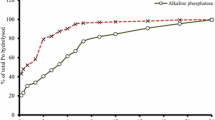Summary
The distribution of phosphatase activity and of phosphate fractions of the soil in the proximity of roots was studied in order to evaluate the significance of phosphatases in P nutrition of various plants (Brassica oleracea, Allium cepa, Triticum aestivum, Trifolium alexandrinum). A considerable increase in both acid and alkaline phosphatase activity in all the four soil-root interfaces was observed. Maximum distances from the root surface at which activity increases were observed ranged from 2.0 mm to 3.1 mm for acid phosphatase and from 1.2 mm to 1.6 mm for alkaline phosphatase. The increase in phosphatase activity depended upon plant age, plant species and soil type. A significant correlation was noticed between the depletion of organic P and phosphatase activity in the rhizosphere soil of wheat (r = 0.99**) and clover (r = 0.97**). The maximum organic P depletion was 65% in clover and 86% in wheat, which was observed within a distance from the root of 0.8 mm in clover and 1.5 mm in wheat. Both the phosphatases in combination appear to be responsible for the depletion of organic P.
Similar content being viewed by others

References
Barber SA (1984) Soil nutrient bioavailability. Wiley, New York
Bhat KKS, Nye PH, Baldwin JP (1976) Diffussion of phosphate to plant roots in soil. IV. The concentration distance profile in the rhizosphere of roots with root hairs in a low-P soil. Plant and Soil 44:63–72
Bieleski RL (1973) Phosphate pools, phosphate transport and phosphate availability. Ann Rev Plant Physiol 24:225
Bowen GD, Rovira AD (1966) Microbial factor in short-term phosphate uptake studies with plant roots. Nature 211:665–666
Burns RG (1982) Enzyme activity in soil: location and a possible role in microbial ecology. Soil Biol Biochem 14:423–427
Casida LE (1955) Phosphatase activity of some common soil fungi. Soil Sci 87:305–310
Greaves MP, Webley DM (1965) A study of the breakdown of organic phosphate by microorganisms from the root region of certain pasture grasses. J Appl Bacteriol 28:454–465
Hedley MJ, White RE, Nye PH (1982) Plant-induced changes in the rhizosphere of rape (Brassica napus var. Emerald) seedlings. III. Changes in L value, soil phosphate fractions and phosphatase activity. New Phytol 91:45–56
Hendriks L, Claassen N, Jungk A (1981) Phosphaiverarmung des wurzelnahen Bodens und Phosphataufnahme von Mais und Raps. Z Pflanzenernahr Bodenkd 144:486–499
Helal HM, Sauerbeck DR (1984) Influence of plant roots on C and P metabolism in soil. Plant and Soil 76:175–182
Hoffmann G (1968) Phosphatasen im Enzymsystem unserer Kulturböden und Möglichkeiten zur Bestimmung ihrer Aktivitat. Z Pflanzenernahr Bodenkd 118:153–160
Jungk A, Barber SA (1974) Phosphate uptake rate of corn roots as related to the proportion of the roots exposed to phosphate. Agron J 66:554–557
Kramer M, Yerdei G (1960) Application of the method of phosphatase activity determination in agricultural chemistry. Soviet Soil Sci 9:1100–1103
Kuchenbuch R, Jungk A (1982) A method for determining concentration profiles at the soil-root interface by thin slicing rhizospheric soil. Plant and Soil 68:391–394
Martin JP (1950) Use of acid, rose bengal and streptomycin in the plate method for estimating soil fungi. Soil Sci 69:215–233
McLaren AD (1975) Soil as a system of humus and clay immobilize enzymes. Chem Scripta 8:97
Nannipieri P, Ceccanti B, Bianchi D, Bonmati M (1985) Fractionation of hydrolase-humus complexes by gel chromatography. Biol Fertil Soils 1:25–29
Scheffer F, Ulrich B, Benzler JH (1960) Bestimmung von Phosphorsaure und Kieselsäure als Molybdänblau. Landwirtsch Forsch 13:191–201
Sharpley AN (1985) Phosphorus cycling in unfertilized and fertilized agricultural soils. Soil Sci Soc Am J 49:905–911
Silberbush M, Shomer-Ilan A, Waisel Y (1981) Root surface phosphatase activity in ecotypes ofAegilops peregrina. Physiol Plant 53:501–504
Tabatabai MA, Bremner JM (1969) Use ofp-nitrophenyl phosphate for assay of phosphatase activity. Soil Biol Biochem 1:301–307
Tarafdar JC, Chhonkar PK (1978) Status of phosphatases in the root-soil interface of leguminous and non-leguminous crops. Z Pflanzenernahr Bodenkd 141:347–351
Tarafdar JC, Chhonkar PK (1979) Phosphatase production by microorganisms isolated from diverse types of soils. Zbl Mikrobiol 134:119–122
Thorton HG (1922) On the development of a standardized agar medium for counting soil bacteria with special regard to the repression of spreading colonies. Ann Biol 9:241–274
Wrenshall CL, Dyer WJ (1939) A method for the determination of organic phosphorus in soils and soil extracts. Can J Res 17:202–205
Author information
Authors and Affiliations
Rights and permissions
About this article
Cite this article
Tarafdar, J.C., Jungk, A. Phosphatase activity in the rhizosphere and its relation to the depletion of soil organic phosphorus. Biol Fert Soils 3, 199–204 (1987). https://doi.org/10.1007/BF00640630
Received:
Issue Date:
DOI: https://doi.org/10.1007/BF00640630



